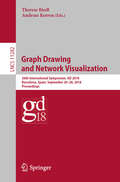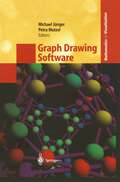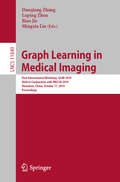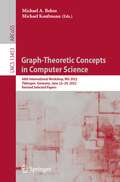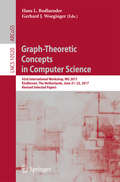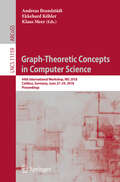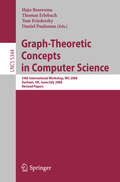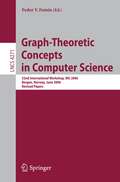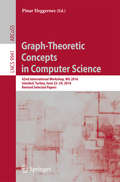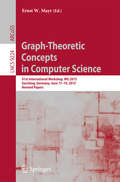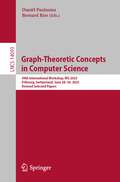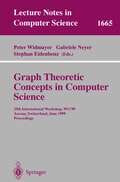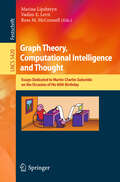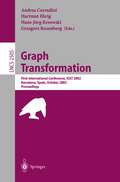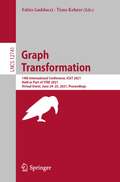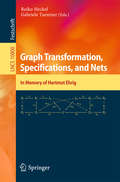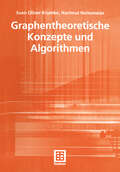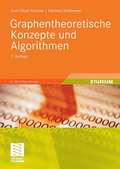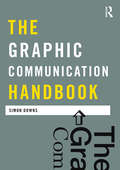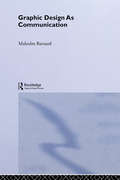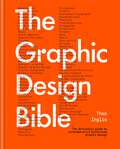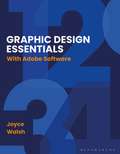- Table View
- List View
Graph Drawing and Network Visualization: 26th International Symposium, GD 2018, Barcelona, Spain, September 26-28, 2018, Proceedings (Lecture Notes in Computer Science #11282)
by Therese Biedl Andreas KerrenThis book constitutes the refereed proceedings of the 26th International Symposium on Graph Drawing and Network Visualization, GD 2018, held in Barcelona, Spain, in September 2018. The 41 full papers presented in this volume were carefully reviewed and selected from 85 submissions. They were organized in topical sections named: planarity variants; upward drawings; RAC drawings; orders; crossings; crossing angles; contact representations; specialized graphs and trees; partially fixed drawings, experiments; orthogonal drawings; realizability; and miscellaneous. The book also contains one invited talk in full paper length and the Graph Drawing contest report.
Graph Drawing Software (Mathematics and Visualization)
by Michael Jünger Petra MutzelAfter an introduction to the subject area and a concise treatment of the technical foundations for the subsequent chapters, this book features 14 chapters on state-of-the-art graph drawing software systems, ranging from general "tool boxes'' to customized software for various applications. These chapters are written by leading experts: they follow a uniform scheme and can be read independently from each other. The text covers many industrial applications.
Graph Learning in Medical Imaging: First International Workshop, GLMI 2019, Held in Conjunction with MICCAI 2019, Shenzhen, China, October 17, 2019, Proceedings (Lecture Notes in Computer Science #11849)
by Daoqiang Zhang Luping Zhou Biao Jie Mingxia LiuThis book constitutes the refereed proceedings of the First International Workshop on Graph Learning in Medical Imaging, GLMI 2019, held in conjunction with MICCAI 2019 in Shenzhen, China, in October 2019. The 21 full papers presented were carefully reviewed and selected from 42 submissions. The papers focus on major trends and challenges of graph learning in medical imaging and present original work aimed to identify new cutting-edge techniques and their applications in medical imaging.
Graph-Theoretic Concepts in Computer Science: 48th International Workshop, WG 2022, Tübingen, Germany, June 22–24, 2022, Revised Selected Papers (Lecture Notes in Computer Science #13453)
by Michael A. Bekos Michael KaufmannThis LNCS 13453 constitutes the thoroughly refereed proceedings of the 48th International Workshop on Graph-Theoretic Concepts in Computer Science, WG 2022.The 32 full papers presented in this volume were carefully reviewed and selected from a total of 96 submissions. The WG 2022 workshop aims to merge theory and practice by demonstrating how concepts from Graph Theory can be applied to various areas in Computer Science, or by extracting new graph theoretic problems from applications.
Graph-Theoretic Concepts in Computer Science: 43rd International Workshop, WG 2017, Eindhoven, The Netherlands, June 21-23, 2017, Revised Selected Papers (Lecture Notes in Computer Science #10520)
by Hans L. Bodlaender Gerhard J. WoegingerThis book constitutes the revised selected papers of the 43rd International Workshop on Graph-Theoretic Concepts in Computer Science, WG 2017, held in Eindhoven, The Netherlands, in June 2017.The 31 full papers presented in this volume were carefully reviewed and selected from 71 submissions. They cover a wide range of areas, aiming at connecting theory and applications by demonstrating how graph-theoretic concepts can be applied in various areas of computer science. Another focus is on presenting recent results and on identifying and exploring promising directions of future research.
Graph-Theoretic Concepts in Computer Science: 44th International Workshop, WG 2018, Cottbus, Germany, June 27–29, 2018, Proceedings (Lecture Notes in Computer Science #11159)
by Andreas Brandstädt Ekkehard Köhler Klaus MeerThis book constitutes the revised selected papers of the 44th International Workshop on Graph-Theoretic Concepts in Computer Science, WG 2018, held in Cottbus, Germany, in June 2018. The 30 full papers presented in this volume were carefully reviewed and selected from 66 submissions. They cover a wide range of areas, aiming at connecting theory and applications by demonstrating how graph-theoretic concepts can be applied in various areas of computer science. Another focus is on presenting recent results and on identifying and exploring promising directions of future research.
Graph-Theoretic Concepts in Computer Science: 34th International Workshop, WG 2008, Durham, UK, June 30 -- July 2, 2008, Revised Papers (Lecture Notes in Computer Science #5344)
by Hajo Broersma Thomas Erlebach Tom Friedetzky Daniel PaulusmaThe 34th International Workshop on Graph-Theoretic Concepts in Computer Science (WG 2008) took place in Van Mildert College at Durham University, UK, 30 June – 2 July 2008. The approximately 80 participants came from va- ous countries all over the world, among them Australia, Brazil, Canada, Chile, Czech Republic, France, Greece, Hungary,Israel, Italy, Japan, The Netherlands, Norway, Poland, Spain, Switzerland, UK and the USA. WG 2008 continued the series of 33 previous WG conferences. Since 1975, the WG conference has taken place 21 times in Germany, four times in The Netherlands, twice in Austria as well as once in Italy, Slovakia, Switzerland, the Czech Republic, France, Norway and now in the UK. The WG conference traditionally aims at uniting theory and practice by demonstrating how graph-theoretic concepts can be applied to various areas in computer science, or by extracting new problems from applications. The goal is to present recent researchresults and to identify and exploredirections of future research. The continuing interest in the WG conferences was re?ected in the number and quality of submissions; 76 papers were submitted and in an evaluation p- cess with four reports per submission, 30 papers were accepted by the Program Committee for the conference. Due to the high number of submissions and the limited schedule of 3 days, various good papers could not be accepted. Therewereexcellent invited talks by Giuseppe Di Battista(UniversitàRoma Tre,Italy)onalgorithmicaspectsof(un)-stableroutingintheInternet,byLeszek G?sieniec (University of Liverpool, UK) on memory-e?cient graph exploration, andbyMartinGrohe(Humboldt-UniversitätzuBerlin,Germany)onalgorithmic meta theorems.
Graph-Theoretic Concepts in Computer Science: 32nd International Workshop, WG 2006, Bergen, Norway, June 22-23, 2006, Revised Papers (Lecture Notes in Computer Science #4271)
by Fedor V. FominThis book constitutes the thoroughly refereed post-proceedings of the 32nd International Workshop on Graph-Theoretic Concepts in Computer Science, WG 2006, held in Bergen, Norway in June 2006. The 30 revised full papers presented together with one invited paper were carefully selected from 91 submissions. The papers address all aspects of graph-theoretic concepts in computer science.
Graph-Theoretic Concepts in Computer Science: 42nd International Workshop, WG 2016, Istanbul, Turkey, June 22-24, 2016, Revised Selected Papers (Lecture Notes in Computer Science #9941)
by Pinar HeggernesThis book constitutes revised selected papers from the 42nd International Workshop on Graph-Theoretic Concepts in Computer Science, WG 2016, held in Istanbul, Turkey, in June 2016. The 25 papers presented in this volume were carefully reviewed and selected from 74 submissions.The WG conferences aim to connect theory and practice by demonstrating how graph-theoretic concepts can be applied to various areas of computer science and by extracting new graph problems from applications. Their goal is to present new research results and to identify and explore directions of future research.
Graph-Theoretic Concepts in Computer Science: 41st International Workshop, WG 2015, Garching, Germany, June 17-19, 2015, Revised Papers (Lecture Notes in Computer Science #9224)
by Ernst W. MayrThis book constitutes revised selected papers from the 41st International Workshop on Graph-Theoretic Concepts in Computer Science, WG 2015, held in Garching, Germany, in June 2015. The 32 papers presented in this volume were carefully reviewed and selected from 79 submissions. They were organized in topical sections named: invited talks; computational complexity; design and analysis; computational geometry; structural graph theory; graph drawing; and fixed parameter tractability.
Graph-Theoretic Concepts in Computer Science: 49th International Workshop, WG 2023, Fribourg, Switzerland, June 28–30, 2023, Revised Selected Papers (Lecture Notes in Computer Science #14093)
by Daniël Paulusma Bernard RiesThis volume constitutes the thoroughly refereed proceedings of the 49th International Workshop on Graph-Theoretic Concepts in Computer Science, WG 2023. The 33 full papers presented in this volume were carefully reviewed and selected from a total of 116 submissions. The WG 2022 workshop aims to merge theory and practice by demonstrating how concepts from graph theory can be applied to various areas in computer science, or by extracting new graph theoretic problems from applications.
Graph-Theoretic Concepts in Computer Science: 25th International Workshop, WG'99, Ascona, Switzerland, June 17-19, 1999 Proceedings (Lecture Notes in Computer Science #1665)
by Peter Widmayer Gabriele Neyer Stephan EidenbenzGraph Theory, Computational Intelligence and Thought: Essays Dedicated to Martin Charles Golumbic on the Occasion of His 60th Birthday (Lecture Notes in Computer Science #5420)
by Marina Lipshteyn Vadim E. Levit Ross McConnellMartin Charles Golumbic has been making seminal contributions to algorithmic graph theory and artificial intelligence throughout his career. He is universally admired as a long-standing pillar of the discipline of computer science. He has contributed to the development of fundamental research in artificial intelligence in the area of complexity and spatial-temporal reasoning as well as in the area of compiler optimization. Golumbic's work in graph theory led to the study of new perfect graph families such as tolerance graphs, which generalize the classical graph notions of interval graph and comparability graph. He is credited with introducing the systematic study of algorithmic aspects in intersection graph theory, and initiated research on new structured families of graphs including the edge intersection graphs of paths in trees (EPT) and trivially perfect graphs. Golumbic is currently the founder and director of the Caesarea Edmond Benjamin de Rothschild Institute for Interdisciplinary Applications of Computer Science at the University of Haifa. He also served as chairman of the Israeli Association of Artificial Intelligence (1998-2004), and founded and chaired numerous international symposia in discrete mathematics and in the foundations of artificial intelligence. This Festschrift volume, published in honor of Martin Charles Golumbic on the occasion of his 60th birthday, contains 20 papers, written by graduate students, research collaborators, and computer science colleagues, who gathered at a conference on subjects related to Martin Golumbic's manifold contributions in the field of algorithmic graph theory and artificial intelligence, held in Jerusalem, Tiberias and Haifa, Israel in September 2008.
Graph Transformation: First International Conference, ICGT 2002, Barcelona, Spain, October 7-12, 2002, Proceedings (Lecture Notes in Computer Science #2505)
by Andrea Corradini Hartmut Ehrig Hans-Jörg Kreowski Grzegorz RozenbergICGT 2002 was the ?rst International Conference on Graph Transformation following a series of six international workshops on graph grammars with - plications in computer science, held in Bad Honnef (1978), Osnabruc ¨ k (1982), Warrenton (1986), Bremen (1990), Williamsburg (1994), and Paderborn (1998). ICGT 2002 was held in Barcelona (Spain), October 7–12, 2002 under the a- pices of the European Association of Theoretical Computer Science (EATCS), the European Association of Software Science and Technology (EASST), and the IFIP Working Group 1.3, Foundations of Systems Speci?cation. The scope of the conference concerned graphical structures of various kinds (like graphs, diagrams, visual sentences and others) that are useful to describe complex structures and systems in a direct and intuitive way. These structures are often augmented by formalisms which add to the static description a further dimension, allowing for the modeling of the evolution of systems via all kinds of transformations of such graphical structures. The ?eld of Graph Transformation is concerned with the theory, applications, and implementation issues of such formalisms. The theory is strongly related to areas such as graph theory and graph - gorithms, formal language and parsing theory, the theory of concurrent and distributed systems, formal speci?cation and veri?cation, logic, and semantics.
Graph Transformation: 14th International Conference, ICGT 2021, Held as Part of STAF 2021, Virtual Event, June 24–25, 2021, Proceedings (Lecture Notes in Computer Science #12741)
by Fabio Gadducci Timo KehrerThis book constitutes the refereed proceedings of the 14th International Conference on Graph Transformation, ICGT 2021, which took place virtually during June 24-25, 2021.The 14 full papers and 2 tool papers presented in this book were carefully reviewed and selected from 26 submissions. They deal with the following topics: theoretical advances; application domains; and tool presentations.
Graph Transformation, Specifications, and Nets: In Memory of Hartmut Ehrig (Lecture Notes in Computer Science #10800)
by Reiko Heckel Gabriele TaentzerThis volume pays tribute to the scientific achievements of Hartmut Ehrig, who passed away in March 2016.The contributions represent a selection from a symposium, held in October 2016 at TU Berlin, commemorating Hartmut’ s life and work as well as other invited papers in the areas he was active in. These areas include Graph Transformation, Model Transformation, Concurrency Theory, in particular Petri Nets, Algebraic Specification, and Category Theory in Computer Science.
Graphentheoretische Konzepte und Algorithmen (XLeitfäden der Informatik)
by Sven Oliver Krumke Hartmut NoltemeierDas Buch enthält eine Einführung in graphentheoretische Grundbegriffe und Basissätze. Graphen werden als Modellierungswerkzeuge für verschiedene Anwendungen aus dem Bereich der Standortplanung, Logistik, Verkehrsplanung, des Scheduling und der Planung von Kommunikationsnetzen vorgestellt. Für die entstehenden graphentheoretischen Probleme werden effiziente Verfahren vorgestellt und rigoros analysiert. Für komplexitätstheoretisch "schwierige" Probleme enthält das Buch effiziente Näherungsverfahren, die schnell Lösungen mit beweisbarer Güte liefern.
Graphentheoretische Konzepte und Algorithmen (XLeitfäden der Informatik)
by Sven Oliver Krumke Hartmut NoltemeierDas Buch enthält eine Einführung in graphentheoretische Grundbegriffe und Basissätze. Graphen werden als Modellierungswerkzeuge für verschiedene Anwendungen aus dem Bereich der Standortplanung, Logistik, Verkehrsplanung, des Scheduling und der Planung von Kommunikationsnetzen vorgestellt. Für die entstehenden graphentheoretischen Probleme werden effiziente Verfahren vorgestellt und rigoros analysiert. Für komplexitätstheoretisch "schwierige" Probleme enthält das Buch effiziente Näherungsverfahren, die schnell Lösungen mit beweisbarer Güte liefern. Die 2. Auflage erscheint in verbesserter Form und alle bekannt gewordenen Fehler wurden korrigiert.
The Graphic Communication Handbook (Media Practice)
by Simon DownsThe Graphic Communication Handbook is a comprehensive and detailed introduction to the theories and practices of the graphics industry. It traces the history and development of graphic design, explores issues that affect the industry, examines its analysis through communications theory, explains how to do each section of the job, and advises on entry into the profession. The Graphic Communication Handbook covers all areas within the industry including pitching, understanding the client, researching a job, thumbnail drawings, developing concepts, presenting to clients, working in 2D, 3D, motion graphics and interaction graphics, situating and testing the job, getting paid, and getting the next job. The industry background, relevant theory and the law related to graphic communications are situated alongside the teaching of the practical elements. Features include: introductions that frame relevant debates case studies, examples and illustrations from a range of campaigns philosophical and technical explanations of topics and their importance.
The Graphic Communication Handbook (Media Practice)
by Simon DownsThe Graphic Communication Handbook is a comprehensive and detailed introduction to the theories and practices of the graphics industry. It traces the history and development of graphic design, explores issues that affect the industry, examines its analysis through communications theory, explains how to do each section of the job, and advises on entry into the profession. The Graphic Communication Handbook covers all areas within the industry including pitching, understanding the client, researching a job, thumbnail drawings, developing concepts, presenting to clients, working in 2D, 3D, motion graphics and interaction graphics, situating and testing the job, getting paid, and getting the next job. The industry background, relevant theory and the law related to graphic communications are situated alongside the teaching of the practical elements. Features include: introductions that frame relevant debates case studies, examples and illustrations from a range of campaigns philosophical and technical explanations of topics and their importance.
Graphic Design as Communication
by Malcolm BarnardWhat is the point of graphic design? Is it advertising or is it art? What purpose does it serve in our society and culture? Malcolm Barnard explores how meaning and identity are at the core of every graphic design project and argues that the role and function of graphic design is, and always has been, communication.Drawing on a range of theoretical approaches including those of Derrida, Saussure, Foucault, and Barthes, and taking examples from advertising, magazines, illustration, website design, comics, greetings cards and packaging, Graphic Design as Communication looks at how graphic design contributes to the formation of social and cultural identities. Malcolm Barnard discusses the ways in which racial/ethnic groups, age groups and gender groups are represented in graphic design, as well as how images and texts communicate with different cultural groups. He also explores how graphic design relates to both European and American modernism, and its relevance to postmodernism and globalisation in the twenty-first century and asks why, when graphic design is such an integral part of our society and culture, it is not acknowledged and understood in the same way that art is.
Graphic Design as Communication
by Malcolm BarnardWhat is the point of graphic design? Is it advertising or is it art? What purpose does it serve in our society and culture? Malcolm Barnard explores how meaning and identity are at the core of every graphic design project and argues that the role and function of graphic design is, and always has been, communication.Drawing on a range of theoretical approaches including those of Derrida, Saussure, Foucault, and Barthes, and taking examples from advertising, magazines, illustration, website design, comics, greetings cards and packaging, Graphic Design as Communication looks at how graphic design contributes to the formation of social and cultural identities. Malcolm Barnard discusses the ways in which racial/ethnic groups, age groups and gender groups are represented in graphic design, as well as how images and texts communicate with different cultural groups. He also explores how graphic design relates to both European and American modernism, and its relevance to postmodernism and globalisation in the twenty-first century and asks why, when graphic design is such an integral part of our society and culture, it is not acknowledged and understood in the same way that art is.
The Graphic Design Bible
by Theo InglisDiscover the history and theory of graphic design from the past 150 years, and how that comes to bear on contemporary design. Designer, writer and lecturer Theo Inglis takes readers through the core building blocks of graphic design such as composition, colour, medium and typography, and explores how each has been utilized and revolutionized by designers through history, and up to the present day.This book will expand your knowledge of the world of design and provide you with practical take-aways to inform your own creative practice.
Graphic Design Essentials: With Adobe Software
by Joyce WalshLearning by doing is the best way to get to grips with new ideas, and graphic design is no different. Weaving together creative strategies and design principles with step-by-step Adobe software guidance, this unique book helps you to immediately put into practice the concepts as you're learning them so they become second nature.Covering all the introductory topics a designer needs to know – from working with colour and layout, to editing images and designing apps – this fully updated edition of the hugely popular Graphic Design Essentials includes plenty of hands-on instruction and real-life examples to give you a thorough grounding in the fundamentals.This new edition includes:- Coverage of Adobe Illustrator, Photoshop and InDesign - Examples of designs from the UK, US, Canada, Europe, Hong Kong, China, the Middle East and Australia- Smaller supporting activities alongside major project exercises- New design formats, including apps and infographics- Downloadable resources to use within the software instruction
Graphic Design Essentials: With Adobe Software
by Joyce WalshLearning by doing is the best way to get to grips with new ideas, and graphic design is no different. Weaving together creative strategies and design principles with step-by-step Adobe software guidance, this unique book helps you to immediately put into practice the concepts as you're learning them so they become second nature.Covering all the introductory topics a designer needs to know – from working with colour and layout, to editing images and designing apps – this fully updated edition of the hugely popular Graphic Design Essentials includes plenty of hands-on instruction and real-life examples to give you a thorough grounding in the fundamentals.This new edition includes:- Coverage of Adobe Illustrator, Photoshop and InDesign - Examples of designs from the UK, US, Canada, Europe, Hong Kong, China, the Middle East and Australia- Smaller supporting activities alongside major project exercises- New design formats, including apps and infographics- Downloadable resources to use within the software instruction
